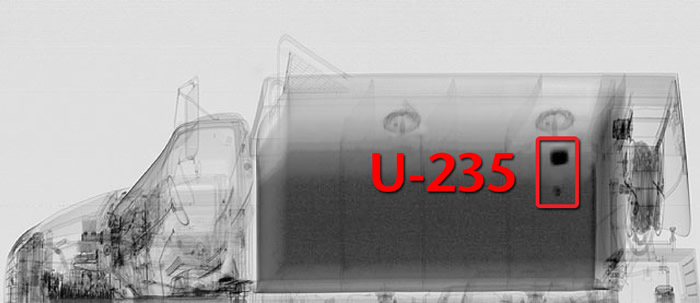Laser-Compton Light Source Technology
Laser-Compton light source technology enables production of mono-energetic gamma rays and x rays. In the gamma-ray regime, these sources enable new, isotope-specific nuclear materials detection systems and photon-based study of nuclear processes (nuclear photonics). Laser-Compton light sources and related nuclear missions concepts were conceived of and realized over the course of the last decade at LLNL.
Created by Compton scattering short-duration laser pulses from relativistic (moving at close to the speed of light) electrons, laser-Compton systems are a new class of light source with extraordinary qualities. The peak brightness of a laser-Compton light source pulse can be 15 orders of magnitude beyond any other man-made light in the million-electron-volt (MeV) spectral range.
 In the laser-Compton light source device, electrons and laser photons crash head-on, creating a backscatter of gamma rays that is one million times more powerful than the incoming photons (Rendering by Kwei-Yu Chu).
In the laser-Compton light source device, electrons and laser photons crash head-on, creating a backscatter of gamma rays that is one million times more powerful than the incoming photons (Rendering by Kwei-Yu Chu).
Gamma rays, the most energetic type of light wave, can penetrate through lead and other thick containers and can be tuned to a specific energy so they predominantly interact with only one kind of material. In the last few years, laser-Compton light source prototypes have identified elements like lithium hidden behind such metal barriers as lead and aluminum (see Science & Technology, June 2014). This capability will allow researchers to address challenges in homeland and international security, nonproliferation and waste identification—for example, in the Department of Homeland Security’s FINDER project for high-confidence detection of nuclear materials to enhance port security.
 FINDER can create images that identify specific isotopes. In this simulation, an x-ray image reveals the presence of Uranium-235 in a truck’s cargo container. The system could be used to inspect well-shielded objects, such as cargo containers moving through a terminal.
FINDER can create images that identify specific isotopes. In this simulation, an x-ray image reveals the presence of Uranium-235 in a truck’s cargo container. The system could be used to inspect well-shielded objects, such as cargo containers moving through a terminal.
This revolutionary leap enables new solutions to a remarkably wide variety of critical and near-term national needs. Laser-Compton light sources can be used to solve the grand challenge of finding and detecting highly enriched uranium; provide a unique tool for performing quantitative assay and imaging of nuclear waste and nuclear fuel systems; enable in-situ 3-D isotope-specific images of aging nuclear weapons; permit fundamental advances in stockpile science by providing picosecond temporal snapshots of isotope positions and velocities in turbulent mix systems; and provide a fundamental new tool for understanding and reinvigorating nuclear physics.
X-band Accelerator Test Stand
NIF & Photon Science researchers have developed an X-band accelerator test stand to investigate accelerator optimization for future upgrades of the laser-Compton light source technology. The test stand is the only such capability in the world to combine both a high-stability, solid-state RF power source with a modern X-band accelerator structure and photo-gun.The test stand is designed to test various concepts that optimize the laser-Compton process for the production of ~2 MeV gamma rays. The initial tests will be done at 30,000 electron volt x-ray energy; 30-keV x rays can be used for medical imaging, NIF target metrology, and dynamic studies of high-energy-density materials. The researchers are currently evaluating these applications.  The X-band laser-Compton test station in Bldg. 194. Team members examine various aspects of the X-band accelerator hardware in preparation for the next experiment. From left: Scott Anderson, Yoonwoo Hwang (UC Irvine), Shawn Betts, David Gibson and Gerry Anderson. Not pictured: Roark Marsh, Po-Chun Yeh (UC Irvine) and Scott Fisher.
The X-band laser-Compton test station in Bldg. 194. Team members examine various aspects of the X-band accelerator hardware in preparation for the next experiment. From left: Scott Anderson, Yoonwoo Hwang (UC Irvine), Shawn Betts, David Gibson and Gerry Anderson. Not pictured: Roark Marsh, Po-Chun Yeh (UC Irvine) and Scott Fisher.
More Information
“Going Deep with MEGA-Rays,” Science & Technology Review, April-May 2011
“T-REX is monster light source with multiple applications,” Newsline, April 4, 2008
“Taking a Gander with Gamma Rays,” Science & Technology Review, December 2006



